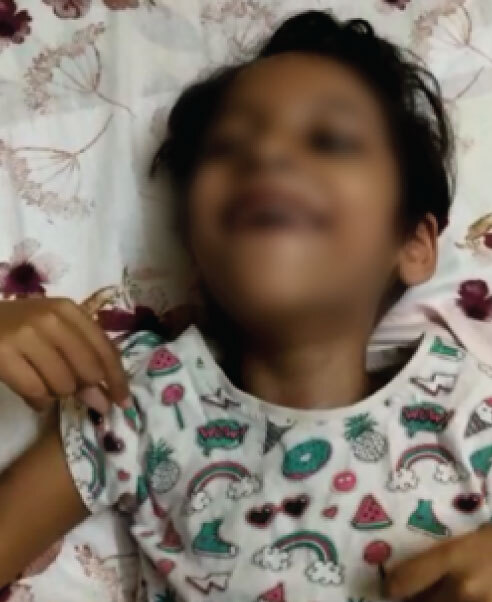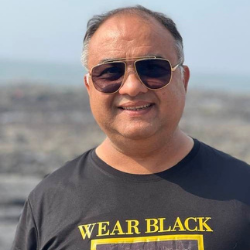
It was the year 2019 when we (Medacsis Team- Ashish Sethia, Tashi Aggarwal, Sandeep Behl and me) hadstarted the noninvasive low-intensity NIR light therapy. A phone call from Mrs Nalini Ramesh Shah wasreceived about a girl of 7 years old. Upon understanding that in the year 2017 because of high fever herneuronal activities were hindered as many respective neurons degenerated. Since 2017 she was on a kind of vegetable state. Her parent who lives in a Chawl in south Mumbai visitedall the hospitals, but the results were in vain. With the reworked history, the baby girl was suffering from TBI due to a high fever causing
- Severe cerebral and cerebellar atrophy, including atrophy of thalami. Apart from this, the white matterchanges in the bilateral periventricular white matter are of questionable significance
- Large areas of restricted diffusions in almost the entire cerebral parenchyma. Bilaterally.
- Mild leptomeningeal, with sever meningoencephalitis.

She had lost the movements of limbs, speech, controls, recognition and cognitive functions completely with severe neuronal damage. The parents and the respective doctors had done whatever was the best in their capacities and abilities.
Now after hearing all this, we had no clue how can we help them However, we know that somehow NIR therapy can be tried as there are no side effects if we restrict the time for which we had our respective physiologist and doctors.
We performed the therapy with the help of Mr Nalini Ramesh Shah for about six months. Then one fine day we received the call from her mother that our little angel could lift her neck (Along with our therapy the neurophysiology therapy was imparted by Mr. Krishna).
We all got goosebumps and started monitoringher other activities. However, for the next two months, we observed nothing. Then one day her father told us that she is audible and had started responding expressing her anger, smiling and other behaviours. It was a moment of joy.
Then suddenly Pandemic Covid-19 struck the world and we had to refrain from the therapy. After about six months we resumed the therapy and by the end of the year, 2021 on a lying down position started taking the flips.
Till now she can maintain those developed activities and no further improvements. However, our little angel motivated us to carry on with our conviction and to date, we have been able to heal insomnia, migraine, stress* and muscular atrophy.
We did try to manage the patients with Parkinson’s disorder and progressive supranuclear palsy, but the results were not motivating.


Influence of Low intensity light waves on neuronal based activities in TBI patient
www.medacsis.in www.theralicht.com
Author: Girish Bhardwaj – Theralicht™ LLP


Abstract:
Infrared light therapy is a form of light therapy, which involves getting exposed to sufficient intensity of infrared light to experience health benefits. NIR light therapy involves shining concentrated wavelengths of light between 810nm to 850nm onto bare skin. The treatment is based on the irradiance and radiance factors of the light photons interacting with light-sensitive molecules within each cell. As NIR light photons reach these molecules, this stimulates the cells’ mitochondria to produce more adenosine triphosphate (ATP), which fuels cellular energy production.
This, in turn, energizes all cells irradiated by the light. Cell-protecting factors such as antioxidants are released to counteract cell degeneration from inflammation. And, the cells are able to perform their functions more efficiently, including repair and regeneration. This heightened functionality has anti-aging benefits as well as the ability to treat the underlying causes of many diseases and disorders.
The infrared spectrum is between 700 nm to 0.1 mm in wavelength, which can be divided into near, mid, and far-infrared spectrum. The longer the wavelength, the lower the frequency and the further the light can penetrate tissues.
Different kinds of infrared wavelengths have different health benefits.
NIR- Near-infrared light, with wavelengths between 700 – 1400 nm, generates the most heat but does not penetrate deep into human tissues. In addition, the 760 – 895 nm range of infrared light can stimulate the mitochondria function, which can increase metabolism, improve tissue repair, and reduce inflammation9, 10.
mNIR- Mid-infrared light, with wavelengths between 1400 – 3000 nm. It penetrates deeper than near-infrared light and generates more heat than far-infrared light. Mid-infrared light can help expand blood vessels and increase circulation so that blood can reach injured or inflamed areas of the body.
Far-infrared light, with wavelengths between 3000 nm – 0.1 mm. Far infrared penetrates deepest into the tissues. Its health benefits come from both generating heat and other properties. Far-infrared light can potently reduce inflammation and oxidative stress. It increases circulation, improves blood vessel and heart functions, reduces pain and fatigue, and normalizes blood pressure11
Introductions:
The case of a baby girl aged 7 years (2019) with TBI with wear off year (2017) 2 years was to be dealt. With the reworked history the baby girl was suffering with TBI due to high fever causing
- Severe cerebral and cerebellar atrophy, including atrophy of thalami. Apart from this the white matter changes in the bilateral periventricular white matter of questionable significance
- Large areas of restricted diffusions in almost entire cerebral parenchyma. Bilaterally.
- Mild leptomeningeal, with sever meningoencephalitis
She had lost the movements of limbs, speech, controls, recognition and cognitive functions completely with severe neuronal damage. The parents and the respective doctors had done whatever the best in their capacities and abilities.
Aim:-
Our main aim was to trigger and normalise cerebral blood flow along with the regeneration of affected thalamic and respective regions. The aim was also to observe the retinal movements while reducing the Oculomotor Dysfunction which got developed coz of TBI.


Method:
The non-invasive low-intensity light therapy was considered for the next couple of months. The default mode network-DMN plays a critical central role in normal brain activities, presenting greater relative deactivation during more cognitively demanding tasks. After deactivation, it allows a distinct network to activate. This network (the central executive network) acts mainly during tasks involving executive functions.
The procedure of red or near-infrared (NIR) light to stimulate or regenerate tissue is known as photobiomodulation. It was discovered that NIR (wavelength 710–940 nm) and red (wavelength 600 nm) (LEDs) can penetrate through the scalp and skull and have the potential to improve the subnormal, cellular activity of compromised brain tissue.
Based on this, different experimental and clinical studies were done to test LED therapy for TBI, The patient was subjected to LILT (690~910 nm) on an alternate day basis with a head wrap around device for 20 minutes in the morning along with the spine cord subjected to (640~840 nm) on alternate day basis. Along with this, the patient was given thyme-leaved gratiola (Btahmi) and promising results were found. It leads us to consider developing different approaches to maximize the positive effects of this therapy and improve the quality of life of TBI patients.
Results:
The significant improvement in holding saliva, and reduction in Oculomotor Dysfunction were noticeable in 6 months. The therapy was continued and in a span of 14 months from the commencement of the therapy (still ON) the movement of the limbs, improvement in metabolism, speech, cognitive functions and recognition have been observed.
The Medacsis-LILT therapy is being continued with the hope that this baby girl will be back to some normalised condition in the next 1-2 years from now (March 2021
References
Corrigan JD, Selassie AW, Orman JA. The epidemiology of traumatic brain injury. J Head Trauma Rehabil. 2010;25(2):72–80. [PubMed] [Google Scholar] Selassie AW, Zaloshnja E, Langlois JA, Miller T, Jones P, Steiner C. Incidence of long-term disability following traumatic brain injury hospitalization in the United States. J Head Trauma Rehabil. 2008;23(2):123–131. [PubMed] [Google Scholar] João Gustavo Rocha Peixoto dos Santos, Wellingson Silva Paiva, and Manoel Jacobsen Teixeira
Alway Y, McKay A, Ponsford J, Schönberger M. Expressed emotion and its relationship to anxiety and depression after traumatic brain injury. Neuropsychol Rehabil. 2012;22(3):374–390. [PubMed] [Google Scholar Schönberger M, Ponsford J, Gould KR, Johnston L. The temporal relationship between depression, anxiety, and functional status after traumatic brain injury: a cross-lagged analysis. J Int Neuropsychol Soc. 2011;17(5):781–787. [PubMed] [Google Scholar]
Donnell AJ, Kim MS, Silva MA, Vanderploeg RD. Incidence of postconcussion symptoms in psychiatric diagnostic groups, mild traumatic brain injury, and comorbid conditions. Clin Neuropsychol. 2012;26(7):1092–1101. [PubMed] [Google Scholar] https://www.ncbi.nlm.nih.gov/pmc/articles/PMC5653719/

Composed by: “Girish Bhardwaj is an Inventor, Author, Entrepreneur, Engineer, Lighting Therapist, Educationist, Lighting and Wellbeing Advisor with the experience of 25 years!”
www.girishbh.com


What an insightful case study, a little step toward non-invasive therapies, congratulations to you all